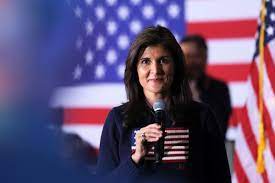In the aftermath of the 2016 election, while journalists delved into the heartlands of Trump’s support and dissected the Clinton campaign, they also turned introspective, examining their own role in the election saga.
The media had extensively covered Hillary Clinton’s emails and provided continuous coverage of Donald Trump’s rallies. Criticism surged from readers and peers, accusing the press of mishandling campaign coverage, potentially contributing to Trump’s victory. It was a moment of introspection.
Yet, as we approach the 2024 elections, little seems to have changed — neither for Trump nor for the journalists covering him. Watching the GOP primary debates and the escalating race, it’s evident that the lessons from 2016 haven’t been wholly absorbed.
Reports on the candidate’s recent use of charged language and his unrestrained social media presence continue to thrust Trump into the spotlight, solidifying his lead in polls against primary rivals. Discussions on policies and the implications of another Trump presidency, which had gained some traction, still take a backseat to the horse-race narrative we believed we had critically examined.
While these stories generate attention, they lack depth. Should this reporting style persist through the 2024 general election campaign, Americans might find themselves ill-prepared for the pivotal vote ahead.
The political press now discusses the precarious state of US democracy extensively but often fails to equip voters with the necessary stories and information crucial for understanding the 2024 elections.
Voters don’t solely consider the fate of their government form; they weigh the personalities, policies, and politics of the candidates. Coverage of the Republican primaries — and the emergence of Trump’s most credible competitor — highlights how the current approach obscures significant stakes and developments, often providing little beyond insider perspectives and tentative campaign forecasts.
The narrative surrounding South Carolina Governor Nikki Haley offers insight. In the primary debates (which Trump skipped), Haley surfaces as a candidate with policy stances that occasionally sharply differ from Trump and other contenders on stage. More assertive in foreign policy, less dogmatic on anti-abortion stances, and less aligned with economic populism, Haley embodies a segment presumed near-extinct within the Republican coalition since Trump’s rise.
This perspective gains support from recent news: Haley secured the endorsement of Americans for Prosperity Action, a SuperPAC founded by David and Charles Koch. While the media delved into campaign strategies and electoral positioning, discussing Haley’s polling position, the SuperPAC’s financial clout, and the desire to transition from the Trump era, there’s a glaring absence of in-depth exploration into policy or the representation of the Koch brothers’ organization within the Republican coalition. References to foreign policy touch upon Haley’s critique of US withdrawals, advocacy for military actions in Iran, and hawkish support for Ukraine.
However, there’s a trove of unexplored dimensions. The Koch brothers epitomize the corporate faction of the party, advocating policies favoring big business and the wealthy — elements shaping their support for Haley. This information isn’t elusive; it simply didn’t surface in the endorsement. While the endorsement mentions Haley’s stances on education, healthcare, anti-unionism, and pro-industry views, it falls short of a comprehensive analysis.
What makes Haley compelling in this race isn’t solely her polling position but her stance within the party. She doesn’t just represent a once-dominant GOP faction; she showcases how that wing has adapted to the Trump era.
Formerly Trump’s UN ambassador, a seemingly odd role for someone diverging significantly from his non-interventionist foreign policy, Haley has toughened her stance on immigration — a departure from the Koch brothers’ historical view. She has strongly embraced anti-trans rhetoric and policies, reframing Trump’s indictments as political maneuvers, highlighting her reluctance to confront Trump head-on.
This clarity about Haley, a figure flexible enough for Trump-skeptical Republicans and independents to project their preferences upon, reveals her as a moderate for removing the Confederate flag post-Charleston’s racist tragedy in 2015, a fiscal hawk for considering Social Security and Medicare cuts, or an advocate for a more inclusive GOP, emphasizing her identities as a woman and Indian-American. Yet, these labels don’t fully capture Haley’s genuine political and policy stances.
By contextualizing both the endorsement and Haley’s policies, we unveil how Trump-opposed Republicans have accommodated him while preserving broader political commitments.
This not only illuminates party composition and voter dynamics but also clarifies Trump-era trends: the supposed economic populist president who enacted substantial tax cuts for the wealthy, aimed to repeal the Affordable Care Act, and engaged with non-union autoworkers during a recent UAW strike in Detroit.
Journalists armed with this perspective could convey the ramifications of a potential second Trump term, transcending the evident threats to democratic governance. A Trump presidency might adversely impact working-class Americans, despite a faction of Republicans interested in economic populism. Yet, concerning actual governance, the Haley faction retains dominance.
Achieving this demands a fundamentally different approach to election coverage. While some journalists challenge Trump, using words like “lie” and “fascism,” the predominant model for election coverage remains anchored in polls, predictions, and behind-the-scenes drama, lacking substantial focus on policy and long-term party transformations.
A recent report from the Columbia Journalism Review analyzing the New York Times and Washington Post front pages in the lead-up to the 2022 midterms corroborates this unchanged landscape since 2016. Both outlets emphasized campaign narratives and intrigue rather than delving into policy intricacies, serving more as entertainment than educational resources for readers.
This model has persisted for years and attracted criticism predating Trump. The media’s tendency to sportify politics, as criticized by journalist Patrick Hruby in 2012, remains largely intact. While media critique remains prominent, structural reforms are elusive due to complexities, risks, and alignment with journalistic values around objectivity and balance, which prove challenging in analytical and contextual coverage. Moreover, reader engagement, often skewed toward non-policy stories, further impedes change in a media landscape where success hinges on audience interaction.
However, change must occur, especially in a democratic system reliant on robust, independent, and informative journalism — crucial when democracy teeters on the edge.





